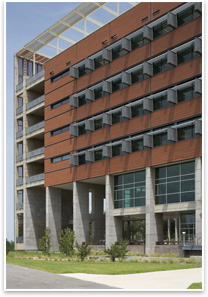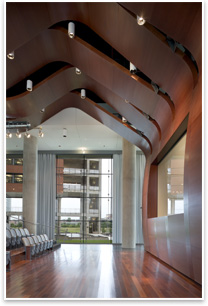Evidence-Based Design: The Deeper Meaning to Sustainability, Building Performance, and Everything Else
A practice sea change that further merges the art and science of architecture
By Zach Mortice
Associate Editor
How do you . . . apply an evidence-based design model to your firm?
Summary: It’s prosaically common now to hear grand proclamations on how the design emphasis on sustainability is drastically reshaping architecture from the ground up and that this is one of the most important shifts in the profession’s modern history. What’s not as widely acknowledged is that there’s a deeper shift in practice that’s driving architects’ ability to design sustainable buildings and will recast the face of the profession even more intensely. Evidence-based design means basing design decisions on empirical, replicable scientific research and data. This concept is what allows designers to monitor and model energy use, building performance, and client use patterns over time and continually compare and refine these factors so buildings lessen their impact on the environment and perform better.

BNIM’s Fayez S. Sarofim Research Building
at the University of Texas Health Science Center in Houston.
“Practically everything [architects designing sustainable buildings] are attempting to put together has its foundation in some kind of rational evidence,” says Kirk Hamilton, FAIA, an architecture professor at Texas A&M and author of Evidence-Based Design for Multiple Building Types. “You might say that a LEED Platinum building project represents the pinnacle, at the moment, of demonstrating an evidence-based model.”
“Simply put:” says KieranTimberlake founder James Timberlake, FAIA, whose firm has been a leader in applying research and evidence-based inquiry to their work: “Form follows performance.”
Certainly, it’s acknowledged that architects have understood this idea at some level as long as the design of buildings has been a formalized profession. For Timberlake, assigning a special term to the concept of backing up design assertions with facts to support them implies that most of the time this doesn’t happen at all, and that’s a sadly missed opportunity. “I personally find the whole term ‘evidence-based design’ odd,” he says. “If we weren’t using evidence before, what the hell were we doing when we were designing? To me and Steve [Kieran], what’s new is the fact that architects are formalizing deep research methodologies to inform design and design practices.”
Scientific method
In Hamilton’s book (co-authored with David Watkins, FAIA), they define evidence-based design as: “A process for the conscientious, explicit, and judicious use of current best evidence from research and practice in making critical decisions, together with an informed client, about the design of each individual and unique project.”
Beyond just sustainability, this can be used to refine any kind of measurable building data: lobby waiting times, employee turnover and productivity, circulation times, the spread of infectious agents in healthcare facilities, patient recovery times, etc. “The domains of knowledge from which relevant interest might be drawn are almost infinite,” Hamilton says.

The auditorium of BNIM’s Fayez S. Sarofim
Research Building at the University of Texas Health Science Center
in Houston.
Evidence-based design also presents a definitively authoritative way to explain how design interventions will get clients a quality return on their investment. Hamilton’s book reviews a series of studies where offices were redesigned by workplace furnishings firm Knoll and employees experienced increased productivity.
“That’s all money in the pocket of a client because these things weren’t designed on the basis of rules of thumb or perhaps gray hair’s previous experience,” Timberlake says.
Hamilton says it doesn’t take a conference room full of PhDs to begin making design decisions in an evidence-based manner. All it really takes is a commitment to change the way a firm practices. “An evidence-based model is not really that different from a traditional business model,” he says. It does require a more open and collaborative relationship with clients than either party might be accustom to.
Often architects will have to depend on clients for information needed to research and verify their design, before a building is completed and afterwards to study a building’s post-occupancy performance. Hamilton believes that it’s best to begin by only researching one to three key design issues; any more might be unwieldy or disruptive. Initially, firms won’t have the resources to begin assembling raw data themselves and will need to reach out to universities, public agencies, trade associations, and advocacy groups for data. “You need not try to collect a library in advance,” he says. “My advice to practitioners is that you should begin with the project that’s already on your desk.”
These key design questions should yield some kind of detailed design hypothesis: “If I increase the amount of day lighting by 40 percent, then employee absenteeism will decrease by 10 percent.” To measure this outcome, architects should look for data that support this hypothesis, with the understanding that definitive proof of causality is elusive. Architects can verify factors that contribute to occupant health, for example (indoor air quality, eye strain, etc.), but it’s difficult to separate design interventions from all the other variables that all affect people’s health.
As an example, Hamilton worked on a healthcare project that led him to research the placement of hand sinks and the effect on hand washing and the spread of illnesses. He discovered that if a hand sink is placed within a 30 degree cone of vision of the caretaker from a patient’s head, the caregiver is even more likely to wash their hands than if they had been exposed to a hand-washing education campaign. Hamilton expects research like this to accelerate in the near future. He cites the Center for Health Design’s Pebble Project as a leading research initiative that will gather and share data applicable to many aspects of healthcare design. “I think we’re at a point where we’re going to see a modest explosion of that kind of stuff,” Hamilton says.
Wither Howard Roark?
Transitioning a firm into an evidence-based design methodology presents a host of firm culture change issues. It’s essentially asking architects to acknowledge all the things they know they don’t know and to abandon their tried and true way of designing in exchange for taking on new and unfamiliar roles as informal researchers. Hamilton and Watkins present this way of practicing as the death of the romantic Fountainhead vision of the architect as an isolated savant whose ideas emerge from inherent wellsprings of raw creativity.
And these evidence-based considerations have to come before lunchtime doodling, Timberlake says. “If you’re doing a napkin sketch and landing that on a client and trying to back into this performance stuff, you’re going to have a problem.”
But if architects aren’t allowed to design in freehand scrawls and sell it to a client, does that mean a steady progression of studied and researched “right” answers to design questions will back architecture into an aesthetic corner?
Architects say that if used correctly, evidence-based design approaches can only help practitioners.
“If it’s really evidence and proof, it just becomes part of the parameters, like gravity or the strength of materials like anything else you have to work with,” says Karl Sonnenberg, AIA, a healthcare partner at ZGF who often works with evidence-based design methods.
Furthermore, limits can inspire creativity not seen in the free-form brush strokes of commissions with no rules. “In design school, I always thought that the hardest project was the one without parameters,” says Steve McDowell, FAIA, of Kansas City, Mo.-based BNIM. His firm’s work with evidence-based design is featured extensively in Hamilton and Watkins’ book.
“There are new data being produced everyday, so the evidence is changing continuously,” says Hamilton. “Each time someone tries to apply it, they’re applying it in a new way. Every project is unique.”
One hundred years, maybe more
Through sustainable design or any other name, evidence-based design has changed (and is still changing) architecture in ways past generations did not foresee, says Timberlake. Contemporary technology now allows the art of building to be recast and improved in nearly every possible way as the science of building. The fundamental structure and measurement tools of this method of practice is already established, and it’s up to architects to fill in the flesh of this model with streams and scads of data about how the built environment works. “We have the tools that can use the facts that allow us to make much better results,” he says. “I think this is the most critical time in architecture possibly since a century or a century and a half ago.”
|




